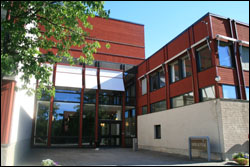Ultuna / Green Innovation Park
Ultuna / Green Innovation Park

Generally
In order to obtain good air quality in the premises, the ventilation is adapted to the number of people and the equipment planned for the rooms. To provide heat and prevent frostbite, there are radiators located along facade walls.
Library
In the library, ventilation is forced by a carbon dioxide sensor that increases the air flow when the carbon dioxide becomes too high.
Or when the temperature rises.
Office
The air supply in offices takes place automatically with a continuous flow.
The normal temperature is controlled via a sensor that ensures that the current setpoint is maintained.
Extended operating time
After regular office hours, i.e. in the evening and on weekends, the ventilation in the building is switched off to save energy. The ventilation can be started manually again via a push button, the ventilation then continues for the set time.
Public areas
In corridors, lighting is automatically controlled via time channel. After a set time, the lighting can be turned on manually via a push button and in certain areas via a presence detector. Some lighting is switched on after normal office hours, so-called led lighting.
Offices and workplaces
Fluorescent luminaires are equipped with high-frequency drivers (HF-drivers) for flicker-free light.
Lighting is switched on and off with a switch inside the door.
ALMAS ALLÉ 18
In the environmental station at Almas Allé 18, household waste is sorted into the fractions:
Tenant's responsibility
The tenant is responsible for the collection and removal of:
Car parking
Parking spaces intended for vehicles with a handicap permit can be found close to the main entrance. Please see the campus map .
Entrances and lifts
The entrances are accessible and all floors can be reached via lift.
RWC
Toilets adapted for the disabled are available on each floor.
SCARED - WARN - ALARM - EXTINGUISH
• save yourself and others around you, but don't take too many risks yourself
• warn others who may be in danger
• alert the Emergency Services by calling 112
• put out the fire if possible
Fires that cannot be extinguished with deployed hand fire extinguishers must be alerted via telephone 112. Limit the source of the fire by closing windows and doors.
Fire cells
The building is divided into a number of fire cells to prevent fire and smoke from spreading.
Each fire cell is delimited by fire-rated walls and doors. In principle, all floors, stairwells, lifts, operating areas and waste rooms have their own fire cells. Doors in fire cell boundaries can be magnetically suspended in the open position for transport and closed manually with a push button marked "fire door closer". When an evacuation alarm is triggered, the doors close automatically within the alarmed area.
Doors in fire cell boundaries must absolutely not be blocked by wedges or the like!
Escape routes / Assembly point
See evacuation plans in corridors.
The stairwells form independent escape routes. Two emergency exits can be reached from each workplace. The escape routes, which are marked with green luminous escape signs, must never be blocked. The green signs are always lit and have a battery backup to illuminate even in the event of a power cut.
If the fire alarm is triggered, all personnel must leave the building, close all doors behind them and gather at the assembly point (See the respective evacuation plan). The staff reports there to the evacuation recipient and leaves their name and group affiliation or equivalent. No one may depart from the assembly point until this is done.